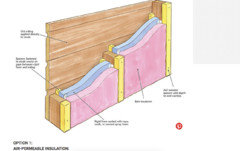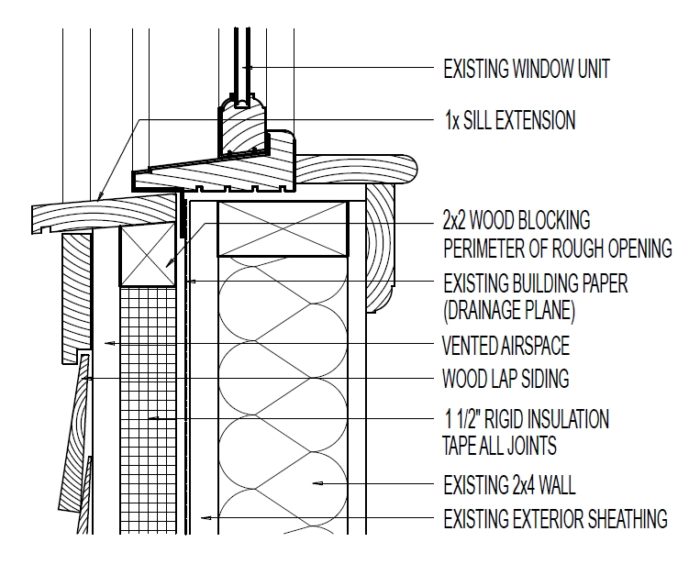Are you wondering if Tyvek goes over plywood? Well, you’ve come to the right place! In this article, we’re going to explore the answer to this common question. So, let’s dive in and discover how Tyvek can help protect your plywood and keep your home safe and sound.
Now, you might be thinking, “What exactly is Tyvek?” Well, Tyvek is a brand of house wrap, which is a moisture control barrier used in construction. It’s made from a unique material that allows moisture vapor to escape but keeps water and air from passing through. So, why would you want to put Tyvek over plywood? That leads us to our next point.
When it comes to plywood, moisture can be a major problem. If water seeps through the plywood, it can cause rot, mold, and structural damage to your home. That’s where Tyvek comes in. By installing Tyvek over plywood, you create a protective barrier that helps keep water out and prevents moisture-related issues. It’s like giving your plywood armor to battle against the elements!
So, to answer the question, “Does Tyvek go over plywood?” The answer is a resounding YES! Tyvek is an excellent choice for protecting your plywood and ensuring the longevity of your home. It’s a simple yet effective solution that can save you from costly repairs and keep your home in top-notch condition. Now that we’ve got that settled, let’s explore the benefits and installation process of using Tyvek on plywood. Get ready to learn some valuable tips and tricks!

Does Tyvek Go Over Plywood?
When it comes to construction projects, proper installation and protection of materials are essential for long-lasting results. One common question that arises is whether Tyvek should be installed over plywood. Tyvek is a popular brand of weather-resistant barrier that helps prevent water, air, and moisture infiltration. In this article, we will explore the benefits and considerations of using Tyvek over plywood, providing you with the information you need to make an informed decision for your construction project.
The Importance of Tyvek
Tyvek is a synthetic material known for its durability, strength, and resistance to water and air. It acts as a protective layer between the exterior cladding and the underlying structure, preventing moisture intrusion and enhancing the overall energy efficiency of the building. When properly installed, Tyvek creates a continuous barrier that helps to reduce the risk of water damage, mold growth, and structural deterioration. It also allows for better air circulation, which can improve indoor air quality.
Benefits of Installing Tyvek Over Plywood
1. Moisture Protection: Plywood, while a strong and commonly used construction material, is not waterproof. By installing Tyvek over plywood, you create an additional layer of protection against moisture intrusion. This is especially important in areas prone to heavy rains or high humidity levels.
2. Energy Efficiency: Tyvek acts as an effective thermal barrier, helping to prevent air leakage and improve insulation in the building envelope. This can lead to increased energy efficiency and reduced heating and cooling costs over time.
3. Mold Prevention: Mold is a common issue in buildings with inadequate moisture control. By using Tyvek over plywood, you create a barrier that prevents moisture from seeping into the walls, reducing the likelihood of mold growth and the associated health risks.
Considerations When Installing Tyvek Over Plywood
1. Proper Installation: To ensure the full benefits of Tyvek, it’s important to follow the manufacturer’s installation guidelines. This includes properly flashing windows and doors, sealing seams, and ensuring a continuous barrier. Improper installation can compromise the effectiveness of Tyvek and lead to moisture infiltration.
2. Compatibility: Some types of plywood may not provide a suitable surface for Tyvek installation. It’s essential to choose a high-quality plywood that is adequately sealed to prevent any moisture penetration. Consult with a construction professional to determine the compatibility of your plywood with Tyvek.
3. Environmental Factors: Consider the climate and weather conditions of your location when deciding to install Tyvek over plywood. If you live in a primarily dry area with minimal rain or humidity, the need for Tyvek may be less significant compared to regions with heavy rainfall or high moisture levels.
Tips for Installing Tyvek Over Plywood
1. Start with a clean and dry plywood surface to ensure proper adhesion of the Tyvek material.
2. Use proper fasteners and tape recommended by the manufacturer to secure the Tyvek in place.
3. Pay attention to detail when sealing seams and around windows, doors, and other openings to create a continuous barrier.
Conclusion
Installing Tyvek over plywood provides additional protection against moisture intrusion, improves energy efficiency, and helps prevent mold growth. However, proper installation and compatibility considerations are crucial for achieving the full benefits of Tyvek. By following the manufacturer’s guidelines and consulting with construction professionals, you can ensure a successful installation and long-lasting results for your construction project.
Key Takeaways: Does Tyvek Go Over Plywood?
- Tyvek is a popular brand of building wrap or housewrap used to provide moisture protection.
- Applying Tyvek over plywood can help prevent water infiltration and promote better insulation.
- Make sure the plywood is clean and dry before installing Tyvek.
- Secure the Tyvek properly, ensuring it is tight and free from wrinkles or gaps.
- Follow manufacturer’s guidelines and best practices when installing Tyvek over plywood.
Frequently Asked Questions
Are you wondering if Tyvek should be installed over plywood? Here are some common questions and answers that can help you understand the use of Tyvek in plywood installations.
1. Can Tyvek be installed directly over plywood?
Yes, Tyvek can be installed directly over plywood as a protective barrier. Tyvek is a breathable, non-woven synthetic material that acts as a weather-resistant barrier against moisture and air infiltration. By installing Tyvek over the plywood sheathing, you can help prevent water penetration and protect the structure from potential damage caused by moisture and condensation.
However, it’s important to note that Tyvek is not a substitute for proper flashing and sealing around windows, doors, and other penetrations. It should be used in conjunction with other building materials and techniques for a complete weatherization system.
2. Why is it important to use Tyvek over plywood?
Using Tyvek over plywood provides an additional layer of protection against moisture infiltration. Plywood is a porous material that can absorb and retain water, leading to structural damage over time. By installing Tyvek over plywood, it acts as a water-resistant barrier, preventing water from seeping into the plywood sheathing and potentially causing rot, mold, or other issues.
In addition to moisture protection, Tyvek also helps to reduce air infiltration. By creating a continuous air barrier, it can improve energy efficiency by preventing drafts and reducing heat loss or gain. This can result in a more comfortable living environment and potentially lower energy bills.
3. Should Tyvek be installed over the interior or exterior side of plywood?
Tyvek should be installed on the exterior side of plywood, facing outward. This allows it to act as a weather-resistant barrier, protecting the plywood from moisture, wind, and other weather conditions. Installing it on the interior side would not provide the same level of protection against external elements.
It’s worth noting that interior moisture barriers, such as vapor retarders, may be used on the interior side of the plywood to control moisture diffusion from the interior spaces into the wall assembly. These barriers serve a different purpose than Tyvek and should not be confused with its exterior application.
4. Can Tyvek be used with other types of sheathing, not just plywood?
Yes, Tyvek can be used with various types of sheathing, including but not limited to plywood. It can be installed over other materials such as oriented strand board (OSB), exterior gypsum sheathing, or rigid foam insulation sheathing. The purpose of Tyvek remains the same – to act as a protective barrier against moisture and air infiltration.
However, it’s important to follow the manufacturer’s guidelines and recommendations when using Tyvek with different sheathing materials. Proper installation techniques, such as sealing seams and properly lapping the Tyvek, should be followed to ensure maximum effectiveness and performance.
5. Do I need to tape the seams of Tyvek when installing it over plywood?
Taping the seams of Tyvek is highly recommended to create a continuous barrier against moisture and air infiltration. Seams can be taped using a compatible flashing tape or Tyvek tape specifically designed for this purpose. Taping the seams ensures a tight seal, preventing any gaps where water or air could potentially enter.
Additionally, it’s important to pay attention to any penetrations such as fasteners or openings for windows and doors. These areas should be properly flashed and sealed with compatible materials to maintain the integrity of the Tyvek barrier system.

**
Summary
**
Putting Tyvek over plywood can protect it from water damage and keep your home dry. However, it’s important to install Tyvek properly by following the manufacturer’s instructions.
If Tyvek is installed incorrectly, it can trap moisture inside the walls and cause more harm than good. Make sure you use the right materials and techniques to ensure the best results.
